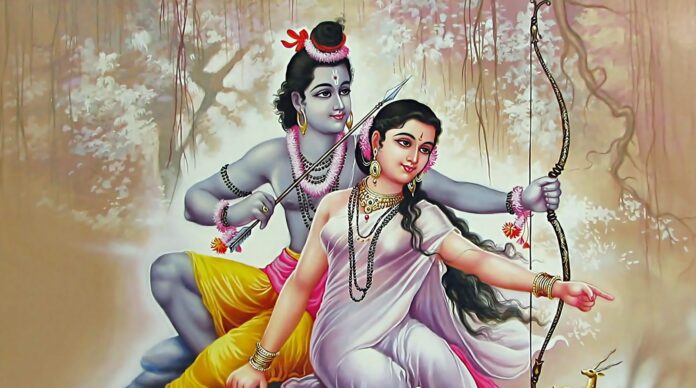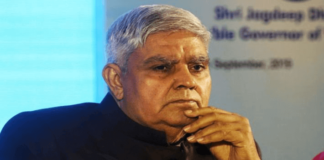The real question behind the Ramayana is how we can live our inner truth and fulfill our highest Dharma.
Sri Rama is much more than an historical person. He represents the inner connection of humanity to the universal Self, Paramatman. Sita Devi is not a mere human woman but a profound cosmic aspiration manifesting through all of nature. Without understanding these deeper meanings we will misunderstand the magnificent story of the Ramayana and what Sri Rama’s defeat of Ravana truly means.
By Dr David Frawley
Human life, though karmically bound to physical reality, is part of an infinite consciousness working through all of life. Developing that unbounded Self-awareness and its complementary compassion is the real teaching behind the sacred depictions of Rama and Sita and their magical life story.
Sita and Rama as the Dual Cosmic Powers
Trying to understand Rama and Sita in mere human terms reflects a limited perception and bondage to Maya, the realm of outer appearances. This does not mean that Rama and Sita had no human existence, but lived as manifestations of a transcendent reality.
Rama and Sita are not merely two separate individuals. Sita is Rama’s feminine reflection. Rama is Sita’s power of action. Their physical manifestation reflects a deeper unity between the two. They are like the Sun and Moon, fire and water, earth and sky, consciousness and bliss. Their energies are all pervasive within and without, a universal metaphor.
Rama and Sita do have an historical aspect in the ancient solar dynasty of kings and sages, where they are prominently mentioned. Rama and Sita are part of the greater history and culture of India and Asia, now extending to the entire world. The Ramayana is asking us to awaken a poetic and yogic insight, much like the Vedic rishis, in a portrayal that appeals to young and old alike.
Finding Sita
The Ramayana revolves around Sita. Who is Sita? Sita is born of a furrow in the ground. She is one of the ayoni-jas or those not born of the womb. She is discovered by King Janaka during his yearly ceremonial plowing of the fields. Yet King Janaka is not a mere ordinary king either. He was the greatest philosopher king (Rajarshi) of ancient India, equal to the rishis. The Upanishads contain his profound dialogues with the sage Yajnavalkya.
As Janaka’s daughter, Sita’s character embodies an exalted philosophical and creative refinement. Sita is related to Sarasvati as the supreme muse of artistic inspiration, to Lakshmi as the capacity to nourish all creatures through the Earth, and to Parvati as the Yogini who can renounce and transcend all limitations. The Atma Shakti or power of consciousness that Sita holds arises from the receptive and silent mind, which is far beyond any outer powers born of self-assertion or material becoming.
The loss and regaining of Sita is our loss and finding the knowledge of our true nature. Lakshman is the discriminating power of the buddhi that protects this inner receptivity. Rama is the true Self (Paramatman) within us that must awaken to reclaim it. Hanuman is the son of Vayu, the cosmic energy that works through the air element. He is our inner prana devoted to the Divine couple, the Sita and Rama within us. Ravana represents the separative self and its illusion powers through the ego-mind, obsessed with external power and control.
A New Vision of Ayodhya
To honor Sri Rama we must strive to live a life of dharma and sadhana. We must be open to the space of cosmic consciousness beyond our biased human intellect and its conceited opinions. To do this we must become Sita and make our lives into a vision and a sacrifice. We must sharpen our intellect as Lakshman to discern the eternal from the transient. We must awaken our inner Hanuman and direct our prana to leap beyond our outer limitations. We must overcome our own inner Ravana, the intractable ignorance and ego urges within us. Then the true light of Deepavali (Diwali) can arise within us and never be extinguished.
It is time that we return to Ayodhya, which is to move from an outer fixation on the physical body to an inner view of life as an endless expansion of unbounded Consciousness. Ayodhya is a divine city of profound wisdom, deep devotion and unity consciousness. Ayodhya as the city of dharma is an ideal within the hearts of all that welcomes every creature and honors every form of sincere aspiration. Sri Rama as the avatar of dharma exemplifies that our true duty is to serve all life, not merely to fulfill our personal desires. We have much to learn from this wonderful story, but must approach it with humility and discernment for its transformational secrets to unfold. These are revealed not when we analyze it by the mind but when we perceive at the core of our being, the spiritual heart (hridaya).
Jai Sri Ram! Jai Sita-Ram!
This article first appeared in www.vedanet.com and it belongs to them.








